Primary Health Care Strategy, Mental Health, and Nursing - NUR3101
VerifiedAdded on 2022/09/08
|7
|1534
|15
Essay
AI Summary
This essay examines a key strategy from the National Primary Health Care Strategic Framework in Australia, focusing on improving access and reducing inequity in the context of mental health. The essay delves into the significant public health issue of mental illness in Australia, highlighting the gaps in primary care services, especially for vulnerable populations such as Indigenous Australians. It explores the social determinants of mental health, including income, education, and housing, and discusses the epidemiological factors relevant to the health issue. The essay then relates the chosen strategy to the WHO's five key principles of primary health care and discusses its relevance to nursing practice, emphasizing nurses' role in patient advocacy, education, and reducing stigma. The conclusion reinforces the strategy's potential as a framework for primary care providers to improve the delivery of mental health services, covering all determinants of mental health.
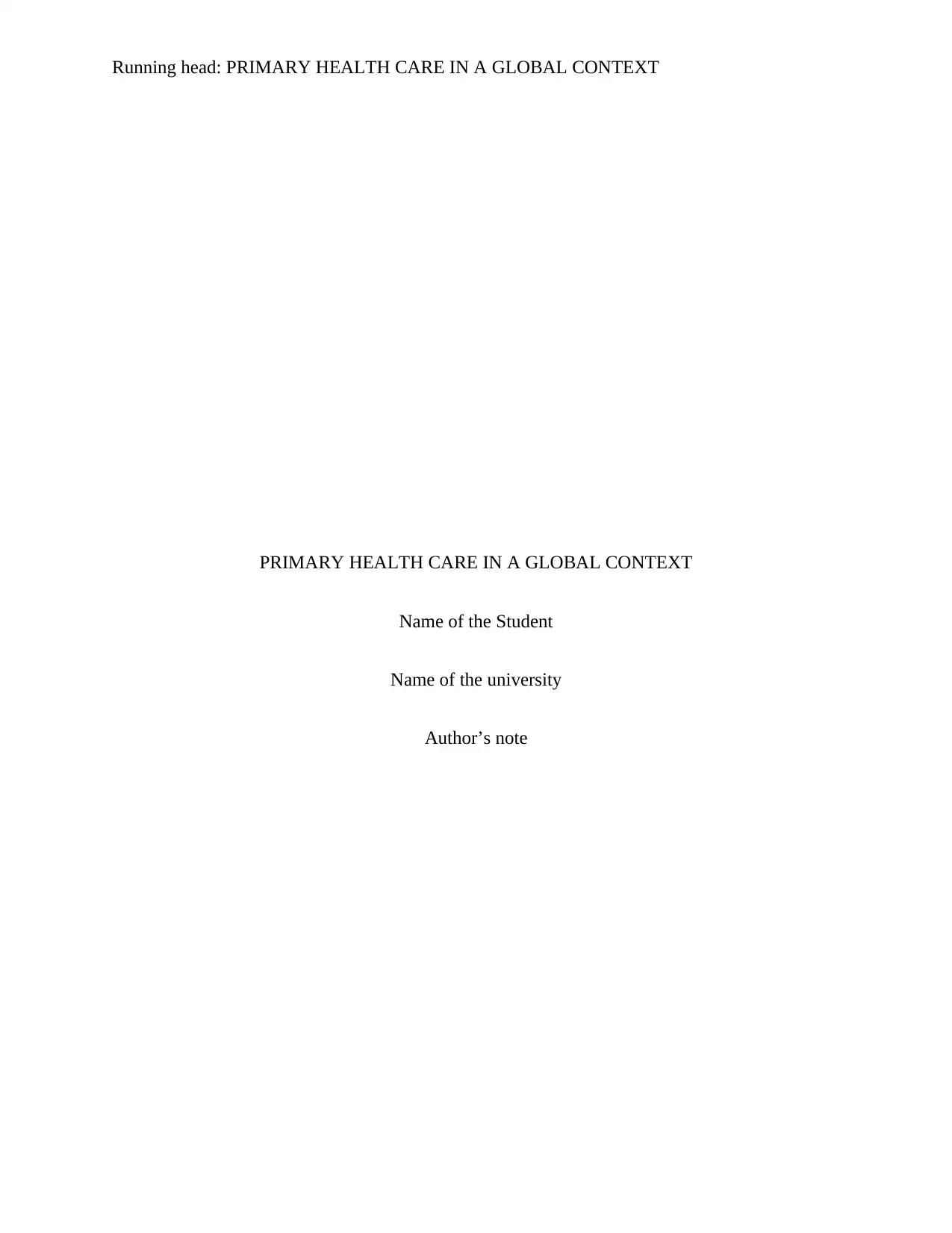
Running head: PRIMARY HEALTH CARE IN A GLOBAL CONTEXT
PRIMARY HEALTH CARE IN A GLOBAL CONTEXT
Name of the Student
Name of the university
Author’s note
PRIMARY HEALTH CARE IN A GLOBAL CONTEXT
Name of the Student
Name of the university
Author’s note
Paraphrase This Document
Need a fresh take? Get an instant paraphrase of this document with our AI Paraphraser
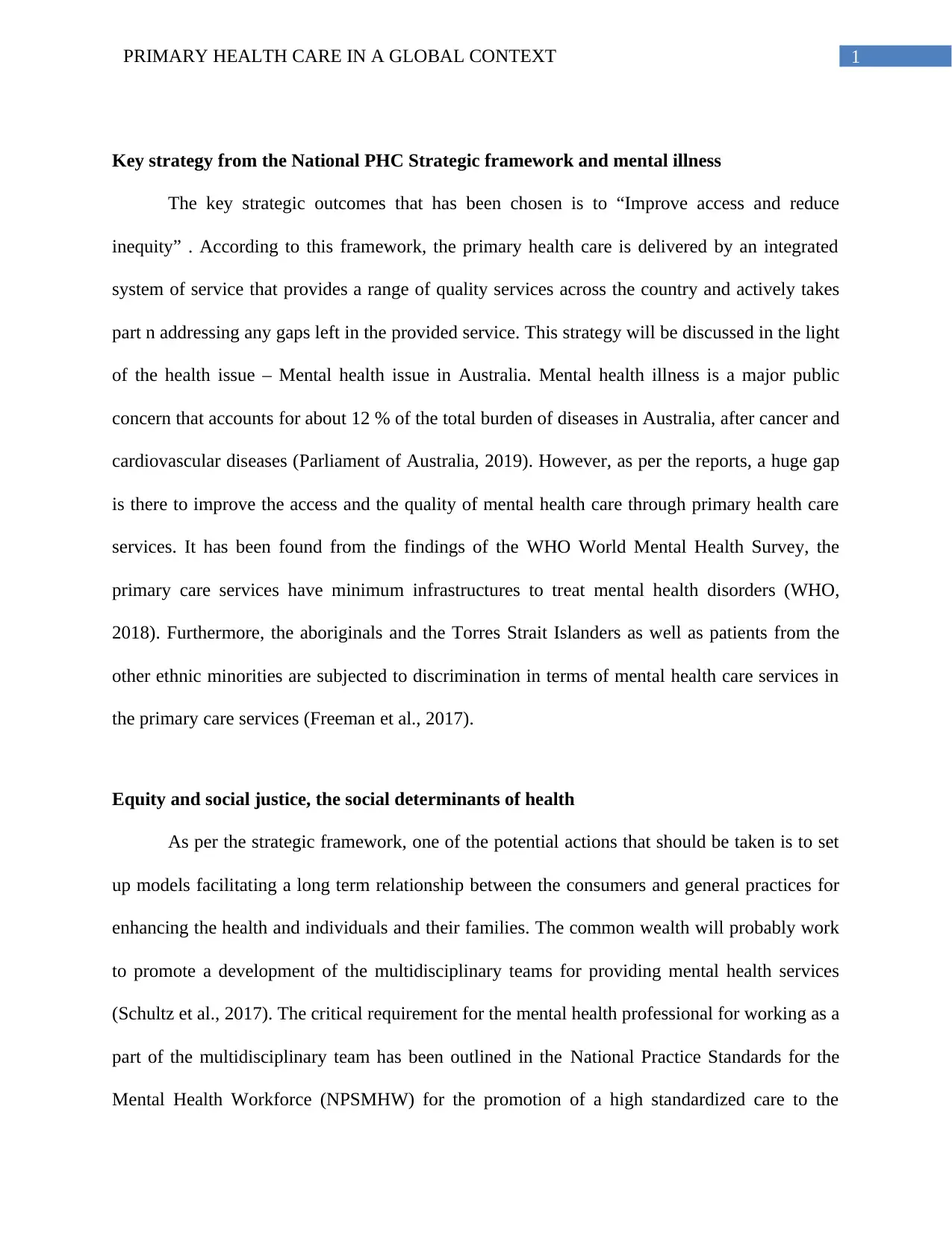
1PRIMARY HEALTH CARE IN A GLOBAL CONTEXT
Key strategy from the National PHC Strategic framework and mental illness
The key strategic outcomes that has been chosen is to “Improve access and reduce
inequity” . According to this framework, the primary health care is delivered by an integrated
system of service that provides a range of quality services across the country and actively takes
part n addressing any gaps left in the provided service. This strategy will be discussed in the light
of the health issue – Mental health issue in Australia. Mental health illness is a major public
concern that accounts for about 12 % of the total burden of diseases in Australia, after cancer and
cardiovascular diseases (Parliament of Australia, 2019). However, as per the reports, a huge gap
is there to improve the access and the quality of mental health care through primary health care
services. It has been found from the findings of the WHO World Mental Health Survey, the
primary care services have minimum infrastructures to treat mental health disorders (WHO,
2018). Furthermore, the aboriginals and the Torres Strait Islanders as well as patients from the
other ethnic minorities are subjected to discrimination in terms of mental health care services in
the primary care services (Freeman et al., 2017).
Equity and social justice, the social determinants of health
As per the strategic framework, one of the potential actions that should be taken is to set
up models facilitating a long term relationship between the consumers and general practices for
enhancing the health and individuals and their families. The common wealth will probably work
to promote a development of the multidisciplinary teams for providing mental health services
(Schultz et al., 2017). The critical requirement for the mental health professional for working as a
part of the multidisciplinary team has been outlined in the National Practice Standards for the
Mental Health Workforce (NPSMHW) for the promotion of a high standardized care to the
Key strategy from the National PHC Strategic framework and mental illness
The key strategic outcomes that has been chosen is to “Improve access and reduce
inequity” . According to this framework, the primary health care is delivered by an integrated
system of service that provides a range of quality services across the country and actively takes
part n addressing any gaps left in the provided service. This strategy will be discussed in the light
of the health issue – Mental health issue in Australia. Mental health illness is a major public
concern that accounts for about 12 % of the total burden of diseases in Australia, after cancer and
cardiovascular diseases (Parliament of Australia, 2019). However, as per the reports, a huge gap
is there to improve the access and the quality of mental health care through primary health care
services. It has been found from the findings of the WHO World Mental Health Survey, the
primary care services have minimum infrastructures to treat mental health disorders (WHO,
2018). Furthermore, the aboriginals and the Torres Strait Islanders as well as patients from the
other ethnic minorities are subjected to discrimination in terms of mental health care services in
the primary care services (Freeman et al., 2017).
Equity and social justice, the social determinants of health
As per the strategic framework, one of the potential actions that should be taken is to set
up models facilitating a long term relationship between the consumers and general practices for
enhancing the health and individuals and their families. The common wealth will probably work
to promote a development of the multidisciplinary teams for providing mental health services
(Schultz et al., 2017). The critical requirement for the mental health professional for working as a
part of the multidisciplinary team has been outlined in the National Practice Standards for the
Mental Health Workforce (NPSMHW) for the promotion of a high standardized care to the
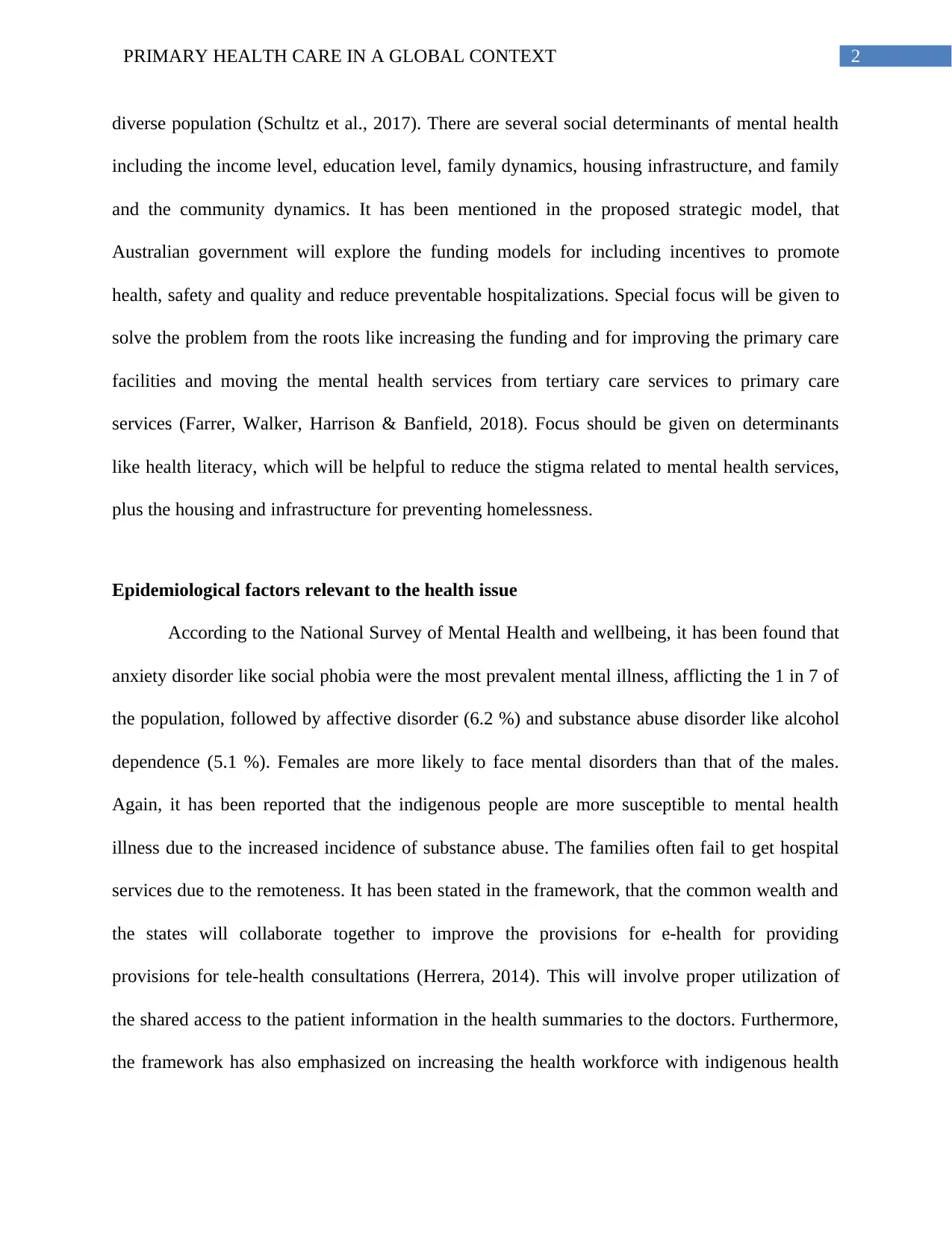
2PRIMARY HEALTH CARE IN A GLOBAL CONTEXT
diverse population (Schultz et al., 2017). There are several social determinants of mental health
including the income level, education level, family dynamics, housing infrastructure, and family
and the community dynamics. It has been mentioned in the proposed strategic model, that
Australian government will explore the funding models for including incentives to promote
health, safety and quality and reduce preventable hospitalizations. Special focus will be given to
solve the problem from the roots like increasing the funding and for improving the primary care
facilities and moving the mental health services from tertiary care services to primary care
services (Farrer, Walker, Harrison & Banfield, 2018). Focus should be given on determinants
like health literacy, which will be helpful to reduce the stigma related to mental health services,
plus the housing and infrastructure for preventing homelessness.
Epidemiological factors relevant to the health issue
According to the National Survey of Mental Health and wellbeing, it has been found that
anxiety disorder like social phobia were the most prevalent mental illness, afflicting the 1 in 7 of
the population, followed by affective disorder (6.2 %) and substance abuse disorder like alcohol
dependence (5.1 %). Females are more likely to face mental disorders than that of the males.
Again, it has been reported that the indigenous people are more susceptible to mental health
illness due to the increased incidence of substance abuse. The families often fail to get hospital
services due to the remoteness. It has been stated in the framework, that the common wealth and
the states will collaborate together to improve the provisions for e-health for providing
provisions for tele-health consultations (Herrera, 2014). This will involve proper utilization of
the shared access to the patient information in the health summaries to the doctors. Furthermore,
the framework has also emphasized on increasing the health workforce with indigenous health
diverse population (Schultz et al., 2017). There are several social determinants of mental health
including the income level, education level, family dynamics, housing infrastructure, and family
and the community dynamics. It has been mentioned in the proposed strategic model, that
Australian government will explore the funding models for including incentives to promote
health, safety and quality and reduce preventable hospitalizations. Special focus will be given to
solve the problem from the roots like increasing the funding and for improving the primary care
facilities and moving the mental health services from tertiary care services to primary care
services (Farrer, Walker, Harrison & Banfield, 2018). Focus should be given on determinants
like health literacy, which will be helpful to reduce the stigma related to mental health services,
plus the housing and infrastructure for preventing homelessness.
Epidemiological factors relevant to the health issue
According to the National Survey of Mental Health and wellbeing, it has been found that
anxiety disorder like social phobia were the most prevalent mental illness, afflicting the 1 in 7 of
the population, followed by affective disorder (6.2 %) and substance abuse disorder like alcohol
dependence (5.1 %). Females are more likely to face mental disorders than that of the males.
Again, it has been reported that the indigenous people are more susceptible to mental health
illness due to the increased incidence of substance abuse. The families often fail to get hospital
services due to the remoteness. It has been stated in the framework, that the common wealth and
the states will collaborate together to improve the provisions for e-health for providing
provisions for tele-health consultations (Herrera, 2014). This will involve proper utilization of
the shared access to the patient information in the health summaries to the doctors. Furthermore,
the framework has also emphasized on increasing the health workforce with indigenous health
⊘ This is a preview!⊘
Do you want full access?
Subscribe today to unlock all pages.

Trusted by 1+ million students worldwide
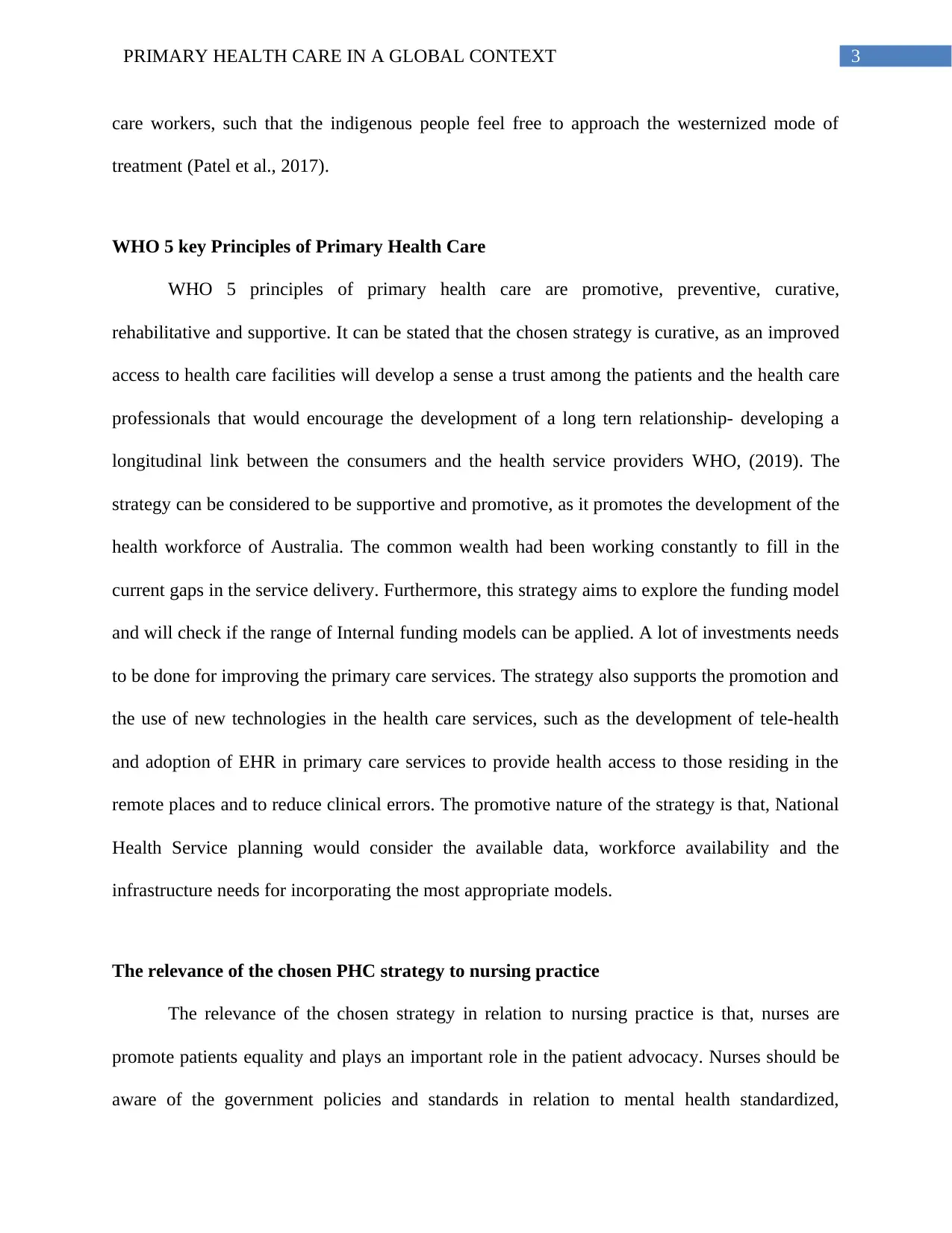
3PRIMARY HEALTH CARE IN A GLOBAL CONTEXT
care workers, such that the indigenous people feel free to approach the westernized mode of
treatment (Patel et al., 2017).
WHO 5 key Principles of Primary Health Care
WHO 5 principles of primary health care are promotive, preventive, curative,
rehabilitative and supportive. It can be stated that the chosen strategy is curative, as an improved
access to health care facilities will develop a sense a trust among the patients and the health care
professionals that would encourage the development of a long tern relationship- developing a
longitudinal link between the consumers and the health service providers WHO, (2019). The
strategy can be considered to be supportive and promotive, as it promotes the development of the
health workforce of Australia. The common wealth had been working constantly to fill in the
current gaps in the service delivery. Furthermore, this strategy aims to explore the funding model
and will check if the range of Internal funding models can be applied. A lot of investments needs
to be done for improving the primary care services. The strategy also supports the promotion and
the use of new technologies in the health care services, such as the development of tele-health
and adoption of EHR in primary care services to provide health access to those residing in the
remote places and to reduce clinical errors. The promotive nature of the strategy is that, National
Health Service planning would consider the available data, workforce availability and the
infrastructure needs for incorporating the most appropriate models.
The relevance of the chosen PHC strategy to nursing practice
The relevance of the chosen strategy in relation to nursing practice is that, nurses are
promote patients equality and plays an important role in the patient advocacy. Nurses should be
aware of the government policies and standards in relation to mental health standardized,
care workers, such that the indigenous people feel free to approach the westernized mode of
treatment (Patel et al., 2017).
WHO 5 key Principles of Primary Health Care
WHO 5 principles of primary health care are promotive, preventive, curative,
rehabilitative and supportive. It can be stated that the chosen strategy is curative, as an improved
access to health care facilities will develop a sense a trust among the patients and the health care
professionals that would encourage the development of a long tern relationship- developing a
longitudinal link between the consumers and the health service providers WHO, (2019). The
strategy can be considered to be supportive and promotive, as it promotes the development of the
health workforce of Australia. The common wealth had been working constantly to fill in the
current gaps in the service delivery. Furthermore, this strategy aims to explore the funding model
and will check if the range of Internal funding models can be applied. A lot of investments needs
to be done for improving the primary care services. The strategy also supports the promotion and
the use of new technologies in the health care services, such as the development of tele-health
and adoption of EHR in primary care services to provide health access to those residing in the
remote places and to reduce clinical errors. The promotive nature of the strategy is that, National
Health Service planning would consider the available data, workforce availability and the
infrastructure needs for incorporating the most appropriate models.
The relevance of the chosen PHC strategy to nursing practice
The relevance of the chosen strategy in relation to nursing practice is that, nurses are
promote patients equality and plays an important role in the patient advocacy. Nurses should be
aware of the government policies and standards in relation to mental health standardized,
Paraphrase This Document
Need a fresh take? Get an instant paraphrase of this document with our AI Paraphraser
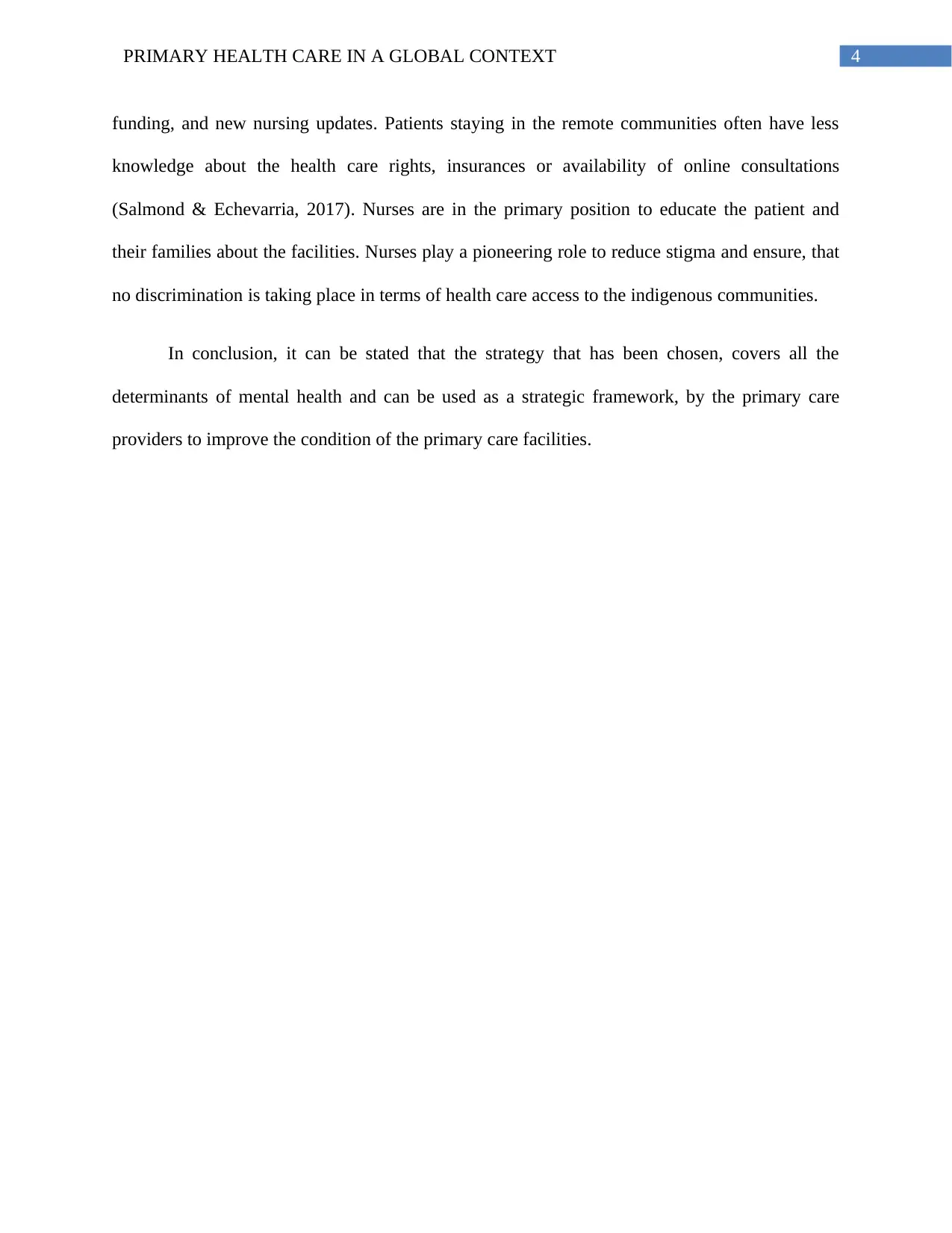
4PRIMARY HEALTH CARE IN A GLOBAL CONTEXT
funding, and new nursing updates. Patients staying in the remote communities often have less
knowledge about the health care rights, insurances or availability of online consultations
(Salmond & Echevarria, 2017). Nurses are in the primary position to educate the patient and
their families about the facilities. Nurses play a pioneering role to reduce stigma and ensure, that
no discrimination is taking place in terms of health care access to the indigenous communities.
In conclusion, it can be stated that the strategy that has been chosen, covers all the
determinants of mental health and can be used as a strategic framework, by the primary care
providers to improve the condition of the primary care facilities.
funding, and new nursing updates. Patients staying in the remote communities often have less
knowledge about the health care rights, insurances or availability of online consultations
(Salmond & Echevarria, 2017). Nurses are in the primary position to educate the patient and
their families about the facilities. Nurses play a pioneering role to reduce stigma and ensure, that
no discrimination is taking place in terms of health care access to the indigenous communities.
In conclusion, it can be stated that the strategy that has been chosen, covers all the
determinants of mental health and can be used as a strategic framework, by the primary care
providers to improve the condition of the primary care facilities.
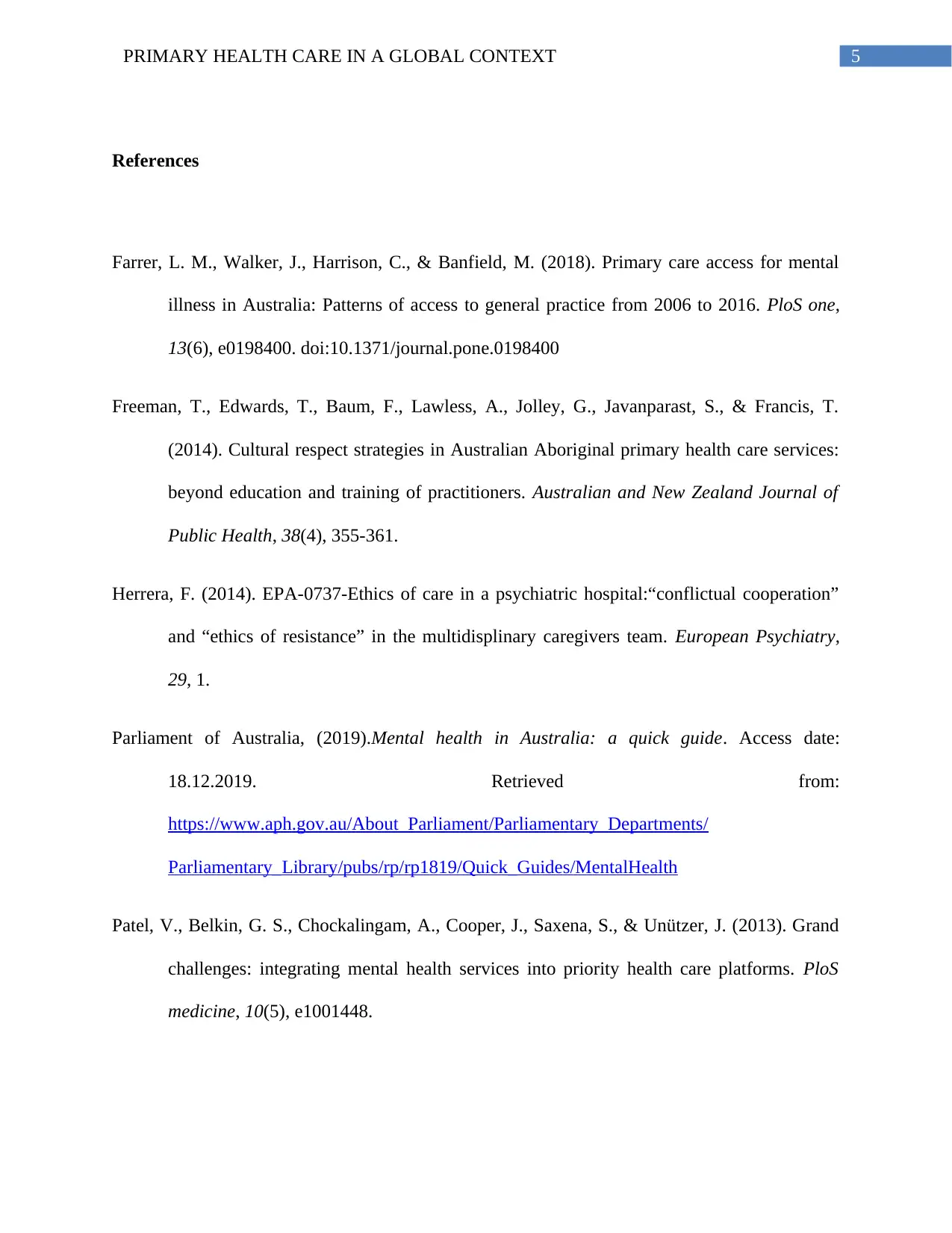
5PRIMARY HEALTH CARE IN A GLOBAL CONTEXT
References
Farrer, L. M., Walker, J., Harrison, C., & Banfield, M. (2018). Primary care access for mental
illness in Australia: Patterns of access to general practice from 2006 to 2016. PloS one,
13(6), e0198400. doi:10.1371/journal.pone.0198400
Freeman, T., Edwards, T., Baum, F., Lawless, A., Jolley, G., Javanparast, S., & Francis, T.
(2014). Cultural respect strategies in Australian Aboriginal primary health care services:
beyond education and training of practitioners. Australian and New Zealand Journal of
Public Health, 38(4), 355-361.
Herrera, F. (2014). EPA-0737-Ethics of care in a psychiatric hospital:“conflictual cooperation”
and “ethics of resistance” in the multidisplinary caregivers team. European Psychiatry,
29, 1.
Parliament of Australia, (2019).Mental health in Australia: a quick guide. Access date:
18.12.2019. Retrieved from:
https://www.aph.gov.au/About_Parliament/Parliamentary_Departments/
Parliamentary_Library/pubs/rp/rp1819/Quick_Guides/MentalHealth
Patel, V., Belkin, G. S., Chockalingam, A., Cooper, J., Saxena, S., & Unützer, J. (2013). Grand
challenges: integrating mental health services into priority health care platforms. PloS
medicine, 10(5), e1001448.
References
Farrer, L. M., Walker, J., Harrison, C., & Banfield, M. (2018). Primary care access for mental
illness in Australia: Patterns of access to general practice from 2006 to 2016. PloS one,
13(6), e0198400. doi:10.1371/journal.pone.0198400
Freeman, T., Edwards, T., Baum, F., Lawless, A., Jolley, G., Javanparast, S., & Francis, T.
(2014). Cultural respect strategies in Australian Aboriginal primary health care services:
beyond education and training of practitioners. Australian and New Zealand Journal of
Public Health, 38(4), 355-361.
Herrera, F. (2014). EPA-0737-Ethics of care in a psychiatric hospital:“conflictual cooperation”
and “ethics of resistance” in the multidisplinary caregivers team. European Psychiatry,
29, 1.
Parliament of Australia, (2019).Mental health in Australia: a quick guide. Access date:
18.12.2019. Retrieved from:
https://www.aph.gov.au/About_Parliament/Parliamentary_Departments/
Parliamentary_Library/pubs/rp/rp1819/Quick_Guides/MentalHealth
Patel, V., Belkin, G. S., Chockalingam, A., Cooper, J., Saxena, S., & Unützer, J. (2013). Grand
challenges: integrating mental health services into priority health care platforms. PloS
medicine, 10(5), e1001448.
⊘ This is a preview!⊘
Do you want full access?
Subscribe today to unlock all pages.

Trusted by 1+ million students worldwide
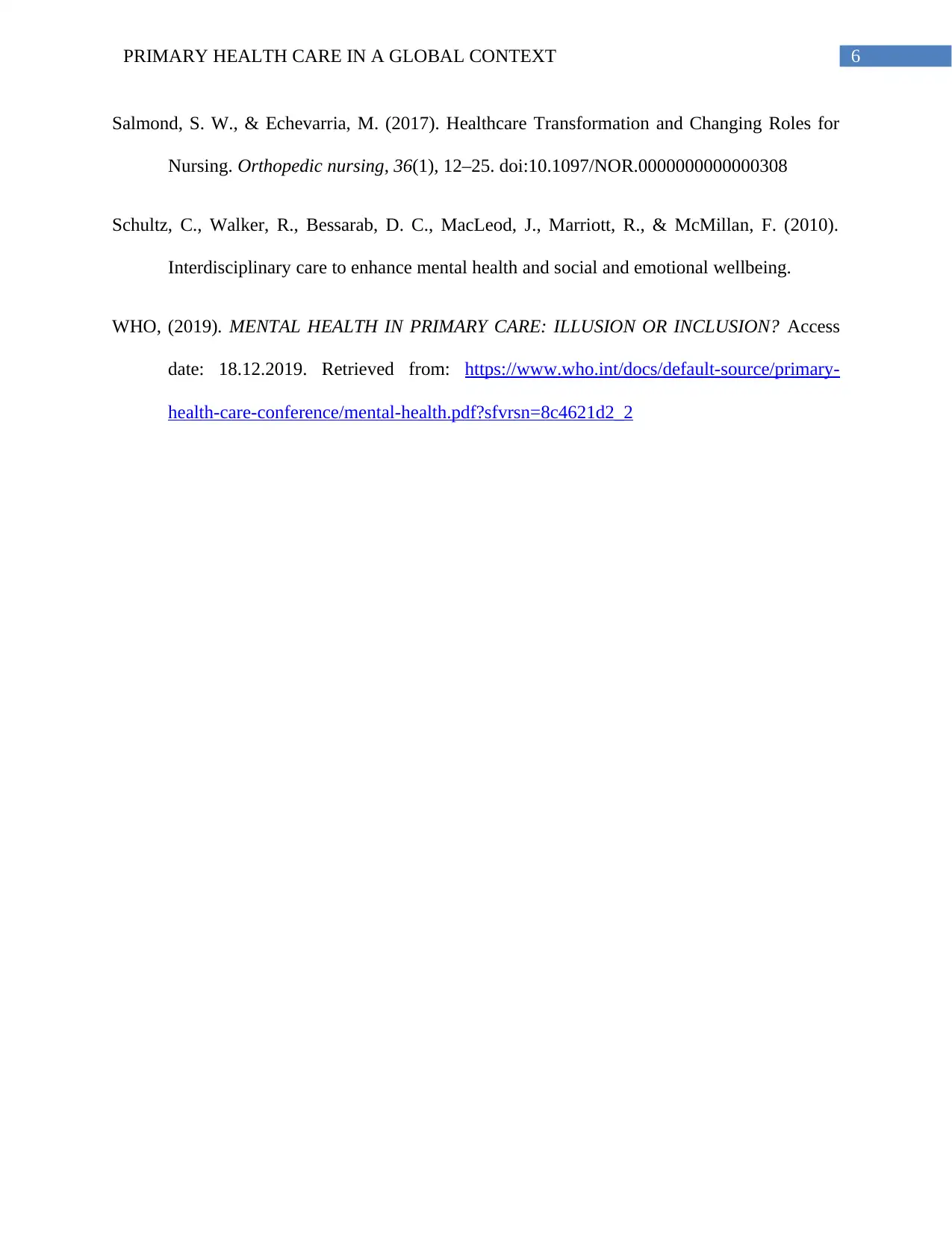
6PRIMARY HEALTH CARE IN A GLOBAL CONTEXT
Salmond, S. W., & Echevarria, M. (2017). Healthcare Transformation and Changing Roles for
Nursing. Orthopedic nursing, 36(1), 12–25. doi:10.1097/NOR.0000000000000308
Schultz, C., Walker, R., Bessarab, D. C., MacLeod, J., Marriott, R., & McMillan, F. (2010).
Interdisciplinary care to enhance mental health and social and emotional wellbeing.
WHO, (2019). MENTAL HEALTH IN PRIMARY CARE: ILLUSION OR INCLUSION? Access
date: 18.12.2019. Retrieved from: https://www.who.int/docs/default-source/primary-
health-care-conference/mental-health.pdf?sfvrsn=8c4621d2_2
Salmond, S. W., & Echevarria, M. (2017). Healthcare Transformation and Changing Roles for
Nursing. Orthopedic nursing, 36(1), 12–25. doi:10.1097/NOR.0000000000000308
Schultz, C., Walker, R., Bessarab, D. C., MacLeod, J., Marriott, R., & McMillan, F. (2010).
Interdisciplinary care to enhance mental health and social and emotional wellbeing.
WHO, (2019). MENTAL HEALTH IN PRIMARY CARE: ILLUSION OR INCLUSION? Access
date: 18.12.2019. Retrieved from: https://www.who.int/docs/default-source/primary-
health-care-conference/mental-health.pdf?sfvrsn=8c4621d2_2
1 out of 7
Related Documents
Your All-in-One AI-Powered Toolkit for Academic Success.
+13062052269
info@desklib.com
Available 24*7 on WhatsApp / Email
![[object Object]](/_next/static/media/star-bottom.7253800d.svg)
Unlock your academic potential
Copyright © 2020–2025 A2Z Services. All Rights Reserved. Developed and managed by ZUCOL.





